Charge at the lidocaine binding site residue Phe-1759 affects permeation in human cardiac voltage-gated sodium channels
- PMID: 17363383
- PMCID: PMC2075178
- DOI: 10.1113/jphysiol.2007.130161
Charge at the lidocaine binding site residue Phe-1759 affects permeation in human cardiac voltage-gated sodium channels
Abstract
Our homology molecular model of the open/inactivated state of the Na(+) channel pore predicts, based on extensive mutagenesis data, that the local anaesthetic lidocaine docks eccentrically below the selectivity filter, such that physical occlusion is incomplete. Electrostatic field calculations suggest that the drug's positively charged amine produces an electrostatic barrier to permeation. To test the effect of charge at this pore level on permeation in hNa(V)1.5 we replaced Phe-1759 of domain IVS6, the putative binding site for lidocaine's alkylamino end, with positively and negatively charged residues as well as the neutral cysteine and alanine. These mutations eliminated use-dependent lidocaine block with no effect on tonic/rested state block. Mutant whole cell currents were kinetically similar to wild type (WT). Single channel conductance (gamma) was reduced from WT in both F1759K (by 38%) and F1759R (by 18%). The negatively charged mutant F1759E increased gamma by 14%, as expected if the charge effect were electrostatic, although F1759D was like WT. None of the charged mutations affected Na(+)/K(+) selectivity. Calculation of difference electrostatic fields in the pore model predicted that lidocaine produced the largest positive electrostatic barrier, followed by lysine and arginine, respectively. Negatively charged glutamate and aspartate both lowered the barrier, with glutamate being more effective. Experimental data were in rank order agreement with the predicted changes in the energy profile. These results demonstrate that permeation rate is sensitive to the inner pore electrostatic field, and they are consistent with creation of an electrostatic barrier to ion permeation by lidocaine's charge.
Figures

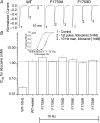
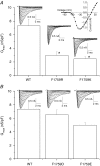
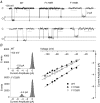
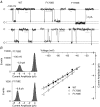
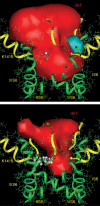
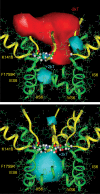

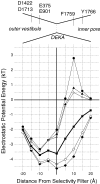
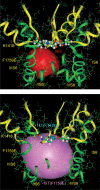


Comment in
-
Local anaesthetic block of sodium channels: raising the barrier.J Physiol. 2007 Jun 1;581(Pt 2):423. doi: 10.1113/jphysiol.2007.133637. Epub 2007 Apr 5. J Physiol. 2007. PMID: 17412761 Free PMC article. No abstract available.
Similar articles
-
Local anaesthetic block of sodium channels: raising the barrier.J Physiol. 2007 Jun 1;581(Pt 2):423. doi: 10.1113/jphysiol.2007.133637. Epub 2007 Apr 5. J Physiol. 2007. PMID: 17412761 Free PMC article. No abstract available.
-
Outward stabilization of the S4 segments in domains III and IV enhances lidocaine block of sodium channels.J Physiol. 2007 Jul 1;582(Pt 1):317-34. doi: 10.1113/jphysiol.2007.134262. Epub 2007 May 17. J Physiol. 2007. PMID: 17510181 Free PMC article.
-
Setting up for the block: the mechanism underlying lidocaine's use-dependent inhibition of sodium channels.J Physiol. 2007 Jul 1;582(Pt 1):11. doi: 10.1113/jphysiol.2007.136671. Epub 2007 May 24. J Physiol. 2007. PMID: 17525109 Free PMC article. No abstract available.
-
Sodium channel molecular conformations and antiarrhythmic drug affinity.Trends Cardiovasc Med. 2010 Jan;20(1):16-21. doi: 10.1016/j.tcm.2010.03.002. Trends Cardiovasc Med. 2010. PMID: 20685573 Free PMC article. Review.
-
Molecular pore structure of voltage-gated sodium and calcium channels.Braz J Med Biol Res. 1994 Dec;27(12):2781-802. Braz J Med Biol Res. 1994. PMID: 7550000 Review.
Cited by
-
Properties of protein drug target classes.PLoS One. 2015 Mar 30;10(3):e0117955. doi: 10.1371/journal.pone.0117955. eCollection 2015. PLoS One. 2015. PMID: 25822509 Free PMC article.
-
A governance of ion selectivity based on the occupancy of the "beacon" in one- and four-domain calcium and sodium channels.Channels (Austin). 2023 Dec;17(1):2191773. doi: 10.1080/19336950.2023.2191773. Channels (Austin). 2023. PMID: 37075164 Free PMC article.
-
The human Nav1.5 F1486 deletion associated with long QT syndrome leads to impaired sodium channel inactivation and reduced lidocaine sensitivity.J Physiol. 2012 Oct 15;590(20):5123-39. doi: 10.1113/jphysiol.2012.235374. Epub 2012 Jul 23. J Physiol. 2012. PMID: 22826127 Free PMC article.
-
Voltage-gated Na channel selectivity: the role of the conserved domain III lysine residue.J Gen Physiol. 2008 Jun;131(6):523-9. doi: 10.1085/jgp.200809991. J Gen Physiol. 2008. PMID: 18504313 Free PMC article. Review. No abstract available.
-
Targeting of sodium channel blockers into nociceptors to produce long-duration analgesia: a systematic study and review.Br J Pharmacol. 2011 Sep;164(1):48-58. doi: 10.1111/j.1476-5381.2011.01391.x. Br J Pharmacol. 2011. PMID: 21457220 Free PMC article.
References
-
- Ahern CA, Eastwood A, Lester H, Dougherty D, Horn R. Investigating cation–pi interactions in the local anesthetic block of voltage gated sodium channels. Biophys J. 2006;22a abstract.
-
- Backx PH, Yue DT, Lawrence JH, Marban E, Tomaselli GF. Molecular localization of an ion-binding site within the pore of mammalian sodium channels. Science. 1992;257:248–251. - PubMed
-
- Benitah J, Balser JR, Marban E, Tomaselli GF. Proton inhibition of sodium channels: mechanism of gating shifts and reduced conductance. J Membr Biol. 1997;155:121–131. - PubMed
Publication types
MeSH terms
Substances
Grants and funding
LinkOut - more resources
Full Text Sources
Miscellaneous

